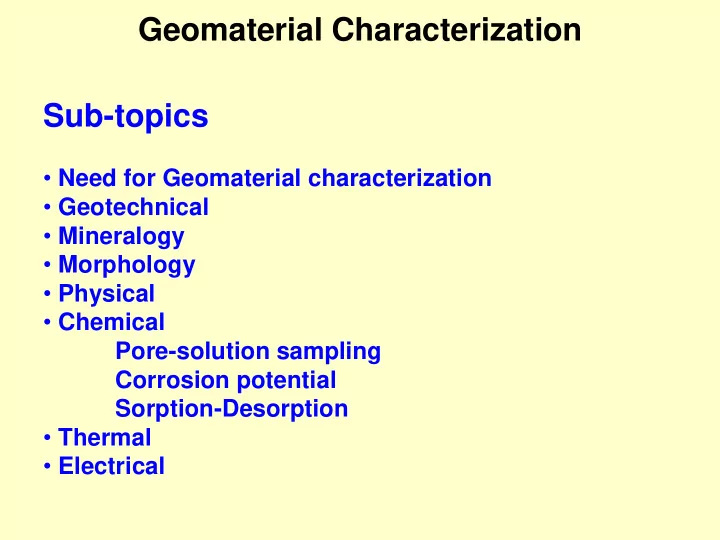

Geomaterial Characterization Sub-topics • Need for Geomaterial characterization • Geotechnical • Mineralogy • Morphology • Physical • Chemical Pore-solution sampling Corrosion potential Sorption-Desorption • Thermal • Electrical
MINERALOGICAL CHARACTERIZATION • X-Ray Diffraction (XRD) • Scanning Electron Microscope (SEM)
Mineralogical Characterization Minerals Present in Materials G= Glassy phase M=Mullite Q= Quartz 600 M C-I Mineral * Material Q CS Anorthite, Quartz, 400 M M M M Montmorillonite Q M Q 200 M M M M M WC Kaolinite, Illite Calcite, Clinoptilolite, Opal CT, IC 0 500 Illite, Smectite, Palygorskite C-II M 400 Relative Intensity RSS Quartz, Feldspar, Hematite M 300 M M BSS Quartz, Feldspar M M M 200 M M M M M FA-I Quartz, Mullite, Hematite M M M 100 FA-II Quartz, Mullite, Hematite 150 G GGBFS C-I Quartz, Mullite 100 C-II Mullite GGBFS Glassy phase 50 * JCPDS 1994 0 Powder diffraction file, 44, 7354-CD ROM 10 20 30 40 50 60 70 80 90 100 (PDF 1- 44), Int. Centre for Diffraction Data , Cu-K (2 Deg.) Pennsylvania, USA. XRD Diffractograms
Minerals the Original and Activated ash samples (treated with NaOH) Minerals Original Activated Quartz Mullite NaP1 zeolite X Hydroxy-sodalite X zeolite
SEM Micrographs (Original ash samples)
SEM Photographs of Activated ash samples
SEM Micrographs (Original ash samples) (a) Sample S1F1 (b) Sample S2F2 (c) Sample SA35F2 (d) Sample SA50F3 (e) Sample SA35F4 (f) Sample SA50F5
Agglomeration of Ash Particles due to Flue Gas Conditioning (a) Sample CA8S12F1 (b) Sample CA8S12F2 (c) Sample CA8S12F3 (d) Sample CA8S12F4 (e) Sample CA8S12F5 (f) Sample CA8S12F6
SEM micrographs of Silica Fumes & Ground Granulated Blast Furnace Slag (GGBFS/BFS) SF BFS
Morphological characterization Confocal micrographs (2-Dimensional) SS1 SS3 CS3 Optical micrographs (3 D) SS1 Glass beads SS2 & SS3
r max in r min-cir S Sphericity, S , r min cir r i N r i i 1 N Roundness, R , R r max in r i r max-in =( R + S )/2 Regularity, , R Sample S 0.715 SS1 0.82 0.61 0.675 SS2 0.76 0.60 0.625 SS3 0.75 0.49 CS1 1.0 0.94 0.89 1.0 0.96 CS2 0.92 1.0 0.95 CS3 0.90
PHYSICAL CHARACTERIZATION Image Analysis System
Gradational analysis 100 100 OLA ALA6 80 80 60 60 % finer 40 40 20 20 0 0 1E-3 1E-3 0.01 0.01 0.1 0.1 1 1 10 10 Particle size (mm) Ultra-sieves
Soft Imaging (Laser Particle Scanning) 5000 4500 4000 SF 3500 3000 2500 2000 1500 Number of particles 1000 500 0 1600 1400 FA 3 1200 1000 BFS 800 600 400 200 0 1400 1200 FA 1 1000 FA 2 800 600 400 200 0 0 3 6 9 12 15 18 21 24 27 30 33 36 39 42 45 Particle size ( m)
Property FA 1 FA 2 FA 3 GGBFS SF G 2.03 2.3 2.38 2.84 2.1 Specific surface area 2988 3602 5048 4073 200000 (cm 2 /g) Sand size (>4.75 mm) % 0 0 0 0 ** Silt size (0.002-0.075 mm) % 100 95 90 97 ** Clay size (<0.002 mm) % 0 5 10 3 ** ** Not applicable Number of particles Percentage of particles Particle size FA-1 FA-2 FA-3 GGBFS SF FA-1 FA-2 FA-3 GGBFS SF Range ( m) 0.0-3.0 944 1295 1410 789 4451 47.6 53.0 53.1 40.3 90.6 3.0-6.0 709 989 1061 816 343 35.8 40.5 39.9 41.7 7.0 6.0-9.0 228 116 148 247 48 11.5 4.8 5.6 12.6 1.0 9.0-12.0 57 17 21 59 33 2.9 0.7 0.8 3.0 0.7 12.0-15.0 24 11 4 16 17 1.2 0.5 0.2 0.8 0.3 15.0-18.0 6 2 2 9 6 0.3 0.1 0.1 0.5 0.1 18.0-21.0 4 1 1 5 2 0.2 0 0 0.3 0.0 21.0-24.0 2 0 0 5 3 0.1 0 0 0.3 0.1 24.0-27.0 1 1 0 2 3 0.1 0 0 0.1 0.1 27.0-30.0 2 1 1 5 2 0.1 0 0 0.3 0.0 30.0-33.0 2 6 3 3 4 0.1 0.2 0.1 0.2 0.1 33.0-36.0 2 1 2 3 2 0.1 0 0.1 0.2 0 36.0-39.0 1 0 0 0 0 0.1 0 0 0 0
Specific Surface Area Determination BET nitrogen adsorption Absorption of Ethylene Glycol Monoethyle Ether (EGME) method Methylene blue (MB) dye method Mercury Intrusion Porosimetry (MIP) He gas pycnometer Blaine’s apparatus
MIP He gas pycnometer
Blaine’s Air Permeability Apparatus (ASTM C 204) Portland cement as a standard reference material Specific-surface area (S B ) 3 S (1 e ) e T S s S B 3 e T (1 e) s s S s is the SSA of cement (= 0.346 m 2 /g) e is the void ratio of the sample e s is the void ratio of cement (= 0.5) T s is the time of manometer drop for cement (= 77.18 s) T is the time of manometer drop for the sample
Thermo Gravimetric Analysis
0 TGA Exo. 20 Weight loss (%) Temp. difference ( T) (Dry air atmosphere) 40 DTA 60 Endo. 80 OLA ALA6 TGA and DTA curve 100 for OLA and ALA6 0 samples 20 40 60 (Inert atmosphere) 80 100 800 400 600 200
0 -3.0 FA-3 0 C) -3.2 DSC TGA Temperature difference( , FA-3 20 -3.4 Weight loss (%) -3.6 Heat flow (mW) 40 -3.8 Exo. -4.0 60 -4.2 DTA -4.4 Endo. 80 -4.6 -4.8 100 -5.0 0 200 400 600 800 0 100 200 300 400 500 600 0 C) Temperature ( 0 C) Temperature (
Recommend
More recommend